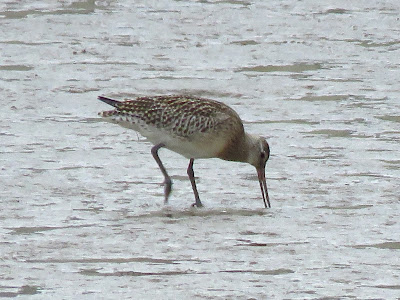I headed to Victoria Dock this morning, hoping to catch up with the returning Curlew. Cool and cloudy with some drizzle to start with, the weather became more settled. As expected, a Curlew fed on the mudflats by the Siemens factory. It's short bill indicated a male.
Caught a lugworm.
Curlew.
The backdrop. A patch of Spartina is growing on the corner of this mudflat.
I carried onto the only stretch of beach in Hull. Currently, a gentle sloping area of shingle, it used to be the frontage of Earle's Shipyard. I was interested in checking if there was any habitat suitable for Sea Aster bees, which have now been found on the south bank of the Humber. Sea Aster bees, Colletes halophilus, feed their larvae on the pollen of Sea Aster, Aster tripolium, and dig their nests in sandy banks. They have been found at Spurn and Welwick, but to my knowledge, not in any other site on the Humber (although Ian Andrews report having seen them at North Ferriby). I looked at the different species of plants growing on the shingle.
A patch of Marram Grass, Ammophila arenaria, with a sandy bank underneath.
Sea Beet, Beta vulgaris
Sea Sandwort, Honckenya peploides?
A patch of Sea Aster growing on a derelict barge.
Marram grass.
A view of the derelict barges.
Sea Aster growing on the derelict barge.
The shingle beach. Much of the shingle is really rubble and there are some rocky patches too, possibly made out of slag?
I notice the tide line of wrack and have a poke to check what's under it. There are lots of sandhoppers, which are too quick for photos, but I manage to get a few photos of some sea slaters, probably the largest I've seen, about 3 cm long.
Sea slater, Ligia oceanica
Sea slater.
I carry on towards The Deep on the promenade. I see a Curlew on the sea wall, also looking like a male, which poses very well.

Male/juvenile curlew.
With my binoculars, I check that the other Curlew is still where I left it on the mudflats, and instead I spot the straight bill of a Godwit! I quickly retrace my steps to have a closer look. It is a Bar-tailed Godwit, feeding frantically on lugworms on the mud flats. The resident Curlew, still there, is not very happy, chasing it away several times. This is bird species number 100 for Hull this year, a very unexpected treat!
I make my way to the half-tide basin. There is a very persistent juvenile Lesser black-backed gull begging to a reluctant parent.
Chasing, calling.
Begging
Finally, the adult regurgitated what looked like a large bit of a bagel.
The young had it for a bit, but then the adult changed its mind and swallowed it back, leaving just a few fragments for the young to eat.
At the half-tide basin, the corner salt-marsh is blooming with sea aster. I scan from the wall and I see some hoverflies and honey-bees, but no sea aster. It is a promising patch though!
On the sea wall closer to The Deep, another curlew, this one, a female (note its much longer bill).
Other birds are using the sea wall:
A singing Woodpigeon.
Woodpigeon and young.
Collared dove feedign on plants growing in between the blocks.
A beach-combing young crow.
Sea Aster bees have a late flying season, but the presence of suitable nesting habitat and food plant bodes well. I'll visit the site in sunny weather next!





























No comments:
Post a Comment